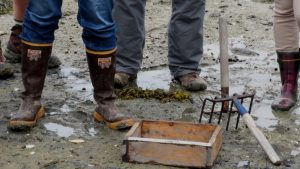Characterizing Watersheds that Influence Coastal Bacteria Pollution
 Institution: University of Maine
Institution: University of Maine
Sponsor: Maine Water Resources Research Institute
Characterizing Estuary Watersheds that Substantially Influence Coastal Bacteria Pollution Trends
This project is designed to refine and advance the knowledge and understanding of coastal watershed-estuary systems initiated by the NSF funded “Safe Beaches and Shellfish” project led by the collaborative New England Sustainability Consortium (NEST). The Safe Beaches and Shellfish project’s goal was to equip resource managers to make better science-based decisions about the closure of beaches and shellfish beds in response to bacterial pollution problems.
Working with stakeholder partners, including representatives from the Maine Dept. of Marine Resources (DMR), the Maine Healthy Beaches Program, the Maine Dept. of Environmental Protection, and the Maine Shellfish Advisory Council, the team identified the research needs and partnership preferences necessary to reach this goal. Managers expressed a need to identify varied watershed responses to rain and runoff, so a coastal pollution vulnerability analysis was conducted based on clustering of coupled watershed-estuary systems along the Maine coast. Results included the clustering of coastal settings and evaluation of their associations with bacteria pollution. One research outcome was the identification of gaps in spatial mapping and characterization of the areas surrounding and directly adjacent to estuaries that we call margin watershed areas (MWAs). Researchers and investigators and the DMR have determined that the poorly represented land areas on the coast have substantial influence on problematic bacteria pollution trends affecting shellfish harvesting areas.
This project focuses on research related to the MWAs by delineating them, identifying their prominent attributes related to runoff and pollution, and determining surface flow pathways from them to tidal estuary water bodies. Once the MWAs are mapped and associated with specific estuary locations, the team will perform analyses of their associations with bacteria pollution using an expanded clustering approach based on metrics that describe newly delineated estuary water bodies and both the non-tidal and margin watershed areas that contribute surface flows to them. The spatial data and vulnerability analyses will be developed in coordination with DMR and other stakeholders involved with shellfish harvesting and management activities in Maine. Results will be presented using formats guided by stakeholder preferences and interpretative descriptions of the new information, its uses, and limitations using estuary reference sites that provide context for the range of land-sea conditions relevant to pollution source, delivery, and residence time problems on the Maine coast.
Team Leader:
- Sean Smith, Associate Professor, Earth and Climate Sciences and Mitchell Center, UMaine
Team Members:
- Kate Beard, Professor, Computing & Information Science, Mitchell Center Faculty Fellow, UMaine
- Bridie McGreavy, Assistant Professor, Communication & Journalism, Mitchell Center Faculty Fellow, UMaine
